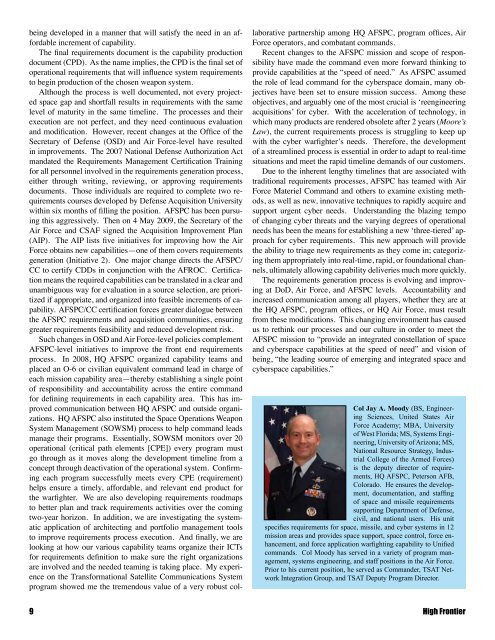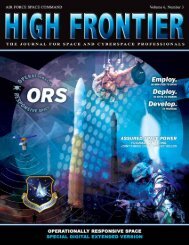Space Acquisition - Air Force Space Command
Space Acquisition - Air Force Space Command
Space Acquisition - Air Force Space Command
Create successful ePaper yourself
Turn your PDF publications into a flip-book with our unique Google optimized e-Paper software.
eing developed in a manner that will satisfy the need in an affordable<br />
increment of capability.<br />
The final requirements document is the capability production<br />
document (CPD). As the name implies, the CPD is the final set of<br />
operational requirements that will influence system requirements<br />
to begin production of the chosen weapon system.<br />
Although the process is well documented, not every projected<br />
space gap and shortfall results in requirements with the same<br />
level of maturity in the same timeline. The processes and their<br />
execution are not perfect, and they need continuous evaluation<br />
and modification. However, recent changes at the Office of the<br />
Secretary of Defense (OSD) and <strong>Air</strong> <strong>Force</strong>-level have resulted<br />
in improvements. The 2007 National Defense Authorization Act<br />
mandated the Requirements Management Certification Training<br />
for all personnel involved in the requirements generation process,<br />
either through writing, reviewing, or approving requirements<br />
documents. Those individuals are required to complete two requirements<br />
courses developed by Defense <strong>Acquisition</strong> University<br />
within six months of filling the position. AFSPC has been pursuing<br />
this aggressively. Then on 4 May 2009, the Secretary of the<br />
<strong>Air</strong> <strong>Force</strong> and CSAF signed the <strong>Acquisition</strong> Improvement Plan<br />
(AIP). The AIP lists five initiatives for improving how the <strong>Air</strong><br />
<strong>Force</strong> obtains new capabilities—one of them covers requirements<br />
generation (Initiative 2). One major change directs the AFSPC/<br />
CC to certify CDDs in conjunction with the AFROC. Certification<br />
means the required capabilities can be translated in a clear and<br />
unambiguous way for evaluation in a source selection, are prioritized<br />
if appropriate, and organized into feasible increments of capability.<br />
AFSPC/CC certification forces greater dialogue between<br />
the AFSPC requirements and acquisition communities, ensuring<br />
greater requirements feasibility and reduced development risk.<br />
Such changes in OSD and <strong>Air</strong> <strong>Force</strong>-level policies complement<br />
AFSPC-level initiatives to improve the front end requirements<br />
process. In 2008, HQ AFSPC organized capability teams and<br />
placed an O-6 or civilian equivalent command lead in charge of<br />
each mission capability area—thereby establishing a single point<br />
of responsibility and accountability across the entire command<br />
for defining requirements in each capability area. This has improved<br />
communication between HQ AFSPC and outside organizations.<br />
HQ AFSPC also instituted the <strong>Space</strong> Operations Weapon<br />
System Management (SOWSM) process to help command leads<br />
manage their programs. Essentially, SOWSM monitors over 20<br />
operational (critical path elements [CPE]) every program must<br />
go through as it moves along the development timeline from a<br />
concept through deactivation of the operational system. Confirming<br />
each program successfully meets every CPE (requirement)<br />
helps ensure a timely, affordable, and relevant end product for<br />
the warfighter. We are also developing requirements roadmaps<br />
to better plan and track requirements activities over the coming<br />
two-year horizon. In addition, we are investigating the systematic<br />
application of architecting and portfolio management tools<br />
to improve requirements process execution. And finally, we are<br />
looking at how our various capability teams organize their ICTs<br />
for requirements definition to make sure the right organizations<br />
are involved and the needed teaming is taking place. My experience<br />
on the Transformational Satellite Communications System<br />
program showed me the tremendous value of a very robust collaborative<br />
partnership among HQ AFSPC, program offices, <strong>Air</strong><br />
<strong>Force</strong> operators, and combatant commands.<br />
Recent changes to the AFSPC mission and scope of responsibility<br />
have made the command even more forward thinking to<br />
provide capabilities at the “speed of need.” As AFSPC assumed<br />
the role of lead command for the cyberspace domain, many objectives<br />
have been set to ensure mission success. Among these<br />
objectives, and arguably one of the most crucial is ‘reengineering<br />
acquisitions’ for cyber. With the acceleration of technology, in<br />
which many products are rendered obsolete after 2 years (Moore’s<br />
Law), the current requirements process is struggling to keep up<br />
with the cyber warfighter’s needs. Therefore, the development<br />
of a streamlined process is essential in order to adapt to real-time<br />
situations and meet the rapid timeline demands of our customers.<br />
Due to the inherent lengthy timelines that are associated with<br />
traditional requirements processes, AFSPC has teamed with <strong>Air</strong><br />
<strong>Force</strong> Materiel <strong>Command</strong> and others to examine existing methods,<br />
as well as new, innovative techniques to rapidly acquire and<br />
support urgent cyber needs. Understanding the blazing tempo<br />
of changing cyber threats and the varying degrees of operational<br />
needs has been the means for establishing a new ‘three-tiered’ approach<br />
for cyber requirements. This new approach will provide<br />
the ability to triage new requirements as they come in; categorizing<br />
them appropriately into real-time, rapid, or foundational channels,<br />
ultimately allowing capability deliveries much more quickly.<br />
The requirements generation process is evolving and improving<br />
at DoD, <strong>Air</strong> <strong>Force</strong>, and AFSPC levels. Accountability and<br />
increased communication among all players, whether they are at<br />
the HQ AFSPC, program offices, or HQ <strong>Air</strong> <strong>Force</strong>, must result<br />
from these modifications. This changing environment has caused<br />
us to rethink our processes and our culture in order to meet the<br />
AFSPC mission to “provide an integrated constellation of space<br />
and cyberspace capabilities at the speed of need” and vision of<br />
being, “the leading source of emerging and integrated space and<br />
cyberspace capabilities.”<br />
Col Jay A. Moody (BS, Engineering<br />
Sciences, United States <strong>Air</strong><br />
<strong>Force</strong> Academy; MBA, University<br />
of West Florida; MS, Systems Engineering,<br />
University of Arizona; MS,<br />
National Resource Strategy, Industrial<br />
College of the Armed <strong>Force</strong>s)<br />
is the deputy director of requirements,<br />
HQ AFSPC, Peterson AFB,<br />
Colorado. He ensures the development,<br />
documentation, and staffing<br />
of space and missile requirements<br />
supporting Department of Defense,<br />
civil, and national users. His unit<br />
specifies requirements for space, missile, and cyber systems in 12<br />
mission areas and provides space support, space control, force enhancement,<br />
and force application warfighting capability to Unified<br />
commands. Col Moody has served in a variety of program management,<br />
systems engineering, and staff positions in the <strong>Air</strong> <strong>Force</strong>.<br />
Prior to his current position, he served as <strong>Command</strong>er, TSAT Network<br />
Integration Group, and TSAT Deputy Program Director.<br />
9 High Frontier











